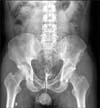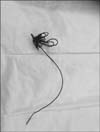Abstract
A few previous reports have described cases wherein electrical wire cables were inserted into the male urethra and bladder. Electrical wire cables are available at home and are easy to insert. However, after they coil in the patient's bladder, they are difficult to remove. In February 2013, a 30-year-old man presented to the emergency room of SMG-SNU Boramae Medical Center with a urethral foreign body. He had inserted an electrical wire cable into his urethra for the purpose of masturbation, despite having a regular sex partner and no underlying disease. A kidney-ureter-bladder radiography showed a tangled wire in his bladder and urethra. On the next day, we tried to remove the wire cystoscopically, but this proved to be impossible because of complex coiling and the slippery surface of the wire. A Pfannenstiel incision was made to remove the foreign body. No postoperative complications were noted.
There have been some case reports of electrical wire cables inserted into the male urethra and bladder [1,2,3,4,5,6,7,8,9,10]. Electrical wire cables are available at home and are easy to insert. Their clinical significance is that after coiling in one's bladder, they are difficult to remove. This case report describes a Korean man who underwent open surgery for the removal of an intravesical electrical wire cable.
In February 2013, a 30-year-old man presented to the emergency room of SMG-SNU Boramae Medical Center with a urethral foreign body. For the past 15 years, he had occasionally inserted an electrical wire cable into his urethra for the purpose of masturbation, despite having no underlying disease. On the day of admission, he had inserted the cable more deeply than he usually did and had been unable to remove it. He had a regular sex partner. A physical examination showed a circumcised glans, and the short wire end extruded from the external urethral meatus. The kidney-ureter-bladder abdominal radiography showed a tangled wire in his bladder and urethra (Fig. 1).
On the next day, he underwent a surgical approach under general anesthesia. We placed him in the lithotomy position and draped him, exposing both the genital and suprapubic areas. We tried to remove the wire cystoscopically, but this proved to be impossible because of complex coiling and the slippery surface of the wire. Next, we made a small Pfannenstiel incision and divided the rectus muscle along its fibers. The bladder was filled with 250 mL of normal saline, and two tagging sutures of 3-0 Vicryl (Ethicon Inc., Somerville, NJ, USA) were placed on the detrusor muscle. Between these sutures, we made a 1.5-cm incision on the bladder detrusor and mucosa, inserted a Kelly clamp into the bladder, and removed the wire successfully (Fig. 2). The bladder was closed with a 3-0 Vicryl continuous suture. No leakage was found after filling the bladder with 420 mL of normal saline.
The patient was discharged 1 day after surgery, and the Foley catheter was removed after 7 days. No postoperative complications were noted.
In Korea, case reports of intraurethral or intravesical foreign bodies resulting from self-insertion during masturbation are rare [10,11]. Twelve cases of intravesical electrical wire cables with a detailed medical history available have been reported worldwide. The median age of these patients is 22 years (range, 14~66 years). The reasons for foreign body insertion were identified in 8 cases: masturbation (5 cases), presence or feeling of urethral obstruction (2 cases), and insertion by a sexual partner (1 case).
In 10 cases, no mental illness was identified. Moslemi and Sorani [6] recently reported a case of an intravesical electrical wire cable in a 47-year-old victim of the Iraq-Iran war. He had been treated for posttraumatic stress disorder. Garg et al [7] reported the case of a urethrovesical foreign body in a man with recurrent convulsions.
Cases of cystoscopic removal of intravesical foreign bodies have been reported by Pal and Bag [8]. In all the other cases, a suprapubic approach was required. A small cystotomy incision was used in most cases, which always led to a successful removal [1,2,3,4,5,6]. Ejstrud and Poulsen [9] described the method of laparoscopic removal. One 10-mm and two 5-mm laparoscopic trocars were suprapubically inserted into the bladder. The knotted electrical wire was untied and removed using two clamps via the 5-mm ports. Ko et al [10] reported the successful removal of a cable by using a 5-mm laparoscopic port. After the port was inserted into the bladder, the cable was cut into several parts by using a pair of laparoscopic scissors. Then, these parts were removed using laparoscopic forceps. Garg et al [7] suprapubically inserted a nephroscope and removed the foreign body by using a pair of forceps.
Urethral foreign bodies may lead to severe complications including penile necrosis and urosepsis [12]. No postoperative complications after the removal of intravesical electrical wire cables have been reported in the literature.
Figures and Tables
References
1. De Bernardis G, Haecker FM. Curious foreign body in the bladder of an adolescent. J Pediatr Surg. 2012; 47:e39–e41.

2. Stravodimos KG, Koritsiadis G, Koutalellis G. Electrical wire as a foreign body in a male urethra: a case report. J Med Case Rep. 2009; 3:49.

3. Krpina K, Sotosek S, Oguić R, Maricić A, Valencić M, Fuckar Z. An unusual case of acute urinary retention. Acta Clin Croat. 2010; 49:177–179.
4. Irekpita E, Imomoh P, Kesieme E, Onuora V. Intravesical foreign bodies: a case report and a review of the literature. Int Med Case Rep J. 2011; 4:35–39.
5. Osca JM, Broseta E, Server G, Ruiz JL, Gallego J, Jimenez-Cruz JF. Unusual foreign bodies in the urethra and bladder. Br J Urol. 1991; 68:510–512.

6. Moslemi MK, Sorani M. Self-inflicted male bladder foreign body: its endoscopic removal using a rigid cystoscope and a suprapubic forceps. Case Rep Urol. 2013; 2013:729013.

7. Garg M, Kumar M, Sankhwar S, Singh V. Self-inflicted long complex urethro-vesical foreign body: is open surgery always needed? BMJ Case Rep. 2013; doi: 10.1136/bcr-2013-009216.

8. Pal DK, Bag AK. Intravesical wire as foreign body in urinary bladder. Int Braz J Urol. 2005; 31:472–474.

9. Ejstrud P, Poulsen J. Laparoscopic removal of an electric wire from the bladder. Br J Urol. 1997; 80:338.

10. Ko YH, Kang SG, Kang SH, Park HS, Lee JG, Kim JJ, et al. Removal of long, complex foreign bodies from bladder using single laparoscopic port under pneumovesicum. J Laparoendosc Adv Surg Tech A. 2010; 20:639–642.

11. Park HJ, Nam JK, Kim JM, Park NC. Foreign body in the Urethra. Korean J Androl. 2005; 23:47–50.




 PDF
PDF ePub
ePub Citation
Citation Print
Print




 XML Download
XML Download